Granite-Block Paving
1913
Bruno Street between Main Street and Alameda Street – map
Declared: 3/7/79
If you’re ever on the Gold Line traveling to downtown from Pasadena, turn to the east when you hit the Chinatown stop. Here, you’ll look down on Bruno Street, containing a great – but small and getting smaller – example of vintage hand-hewn granite, cobblestone street-paving typical of Los Angeles around the turn of the last century (in this case, from 1913).
All of Bruno Street, from Alameda to Main.
Take a look at the section of an 1894 Sanborn fire insurance map below. On this, Bruno Street is a called San Francisco Street. I don’t know when the change was made to Bruno, but it was by 1900. As far as where the name Bruno comes from, it could be it’s from the Spanish word for a little black plum or plum tree. However, in this neck of the woods at the end of the 1800s, plum trees had to be few and far between.
What’s also of note in the above map is the site of Naud’s Ware House. After arriving in L.A. in 1850, baker Edouard Naud first opened a pastry shop on Commercial Street, selling ladyfingers at fifty cents a dozen. He later dove into the wool industry, building a warehouse on Alameda in 1878. The building – by then 600,000 square-feet, owned by Kaspare Kohn, and known as Union Warehouse – fell to a million dollar fire on September 22, 1915. Dozens of businesses were affected by the blaze, yet it appears the only uninsured loss was of $2,500 worth of toothpicks stored by the – heh – Breast Manufacturing Company (imagine a company by that name in Los Angeles, of all places).
From Thompson & West’s 1880 History of Los Angeles County California, here’s a lithograph of the warehouse by C.L. Smith. Below it is a shot of what the site looks like today.
Alameda and Alpine, starring the Gold Line.
You can see by 1906, in another Sanborn map, San Francisco had made the switch to Bruno, and it was Union Warehouse, not Naud’s. (Maybe a street name more appropriate than Bruno would’ve been Taller de Máquinas Street.) Also notice how nine different Southern Pacific spurs crossed Bruno at the time.
Looking up Bruno to Alameda.
Speaking of Naud’s, this area of Los Angeles, thanks to M. Naud and his warehouse, is today still known as Naud Junction. In fact, when boxing promoter Uncle Tom McCarey left Hazard’s Pavilion he built a large barn for matches in the area called, varyingly, Naud Junction Arena, McCarey’s Pavilion, and the Pacific Athletic Club. This was in 1905. I’ve been unable to pin down exactly where it was, but The BAWLI Papers (Boxing as We Like It) reports it was “near the confluence of Main Street, Alhambra Avenue and Macy Street”, while William David Estrada, in his very fine book, The Los Angeles Plaza, says it was “slightly northeast of Alameda Street on Chavez and Quierolo Streets.” (A 1908 city directory lists McCarey and the Pacific Athletic’s office at 102 South Spring, room 331.) In any event, the venue lasted only to 1910 when McCarey put up the outdoor Vernon Arena, competing with Jack Doyle’s indoor Vernon Arena. (Tangent to a tangent: McCarey was the the father of Hollywood director Leo McCarey.)
From USC’s Digital Archive, here’s McCarey’s Pavilion in Jaud Junction. A regular L.A. Live.
McCarey's Pavilion
More of the cobblestoned Bruno, the point of the post:
Homeboy Industries and Homegirl Cafe
In between where once stood Naud’s Warehouse and today’s partially-cobblestoned Bruno Street stands Homeboy Industries and the Homegirl Café. And in between Homeboy Industries and Hollywood Beauty Supply, lies a big pile of Bruno Street’s 96-year-old granite paving-blocks, cut by hand. Hey, landmarked or not, sometimes they need to be removed and “stored”, right?
Sources:
Thompson & West History of Los Angeles County California; Pacific Press 1880 Oakland, CA
“Cause of Large Fire Under Sharp Scrutiny.” The Los Angeles Times; Sep 23, 1915, p. II1
Newmark, Harris Sixty Years in Southern California 1853-1913; The Knickerbocker Press 1916 New York, NY
Kenyon, J. Michael, editor The BAWLI Papers (Boxing as We Like It); May 24, 1999, Issue 84, New York, NY
Springer, Steve “This City Was Full of Fight” The Los Angeles Times; Mar 30, 2006
Estrada, William David The Los Angeles Plaza; The University of Texas Press 2008 Austin, TX
Up next: Stimson Residence
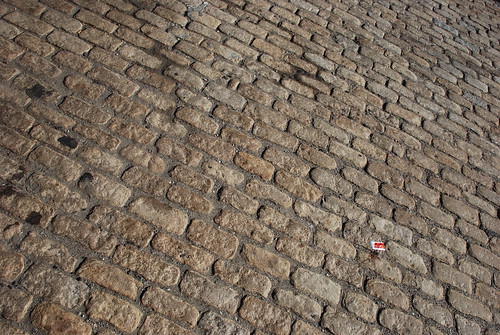
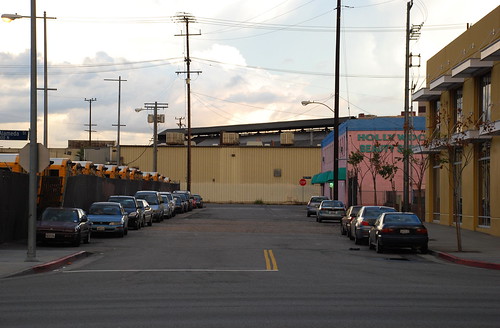
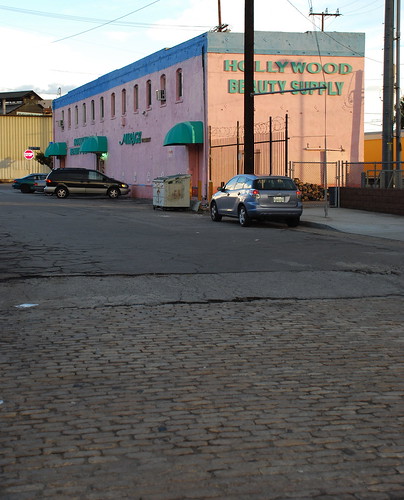
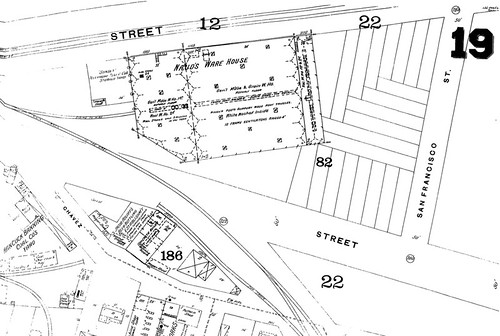
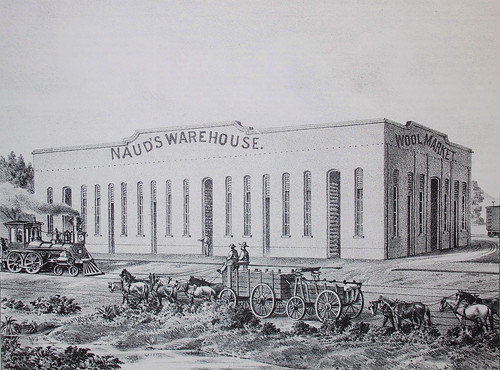
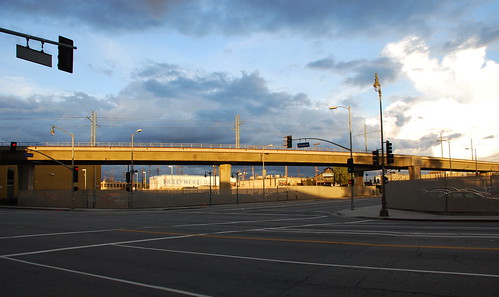
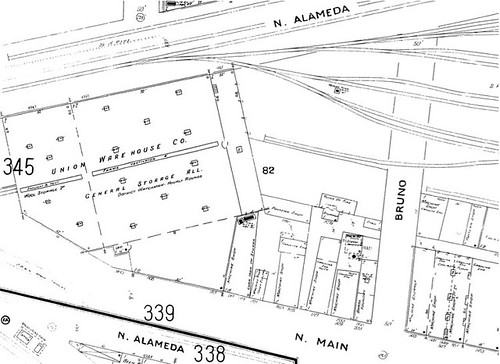
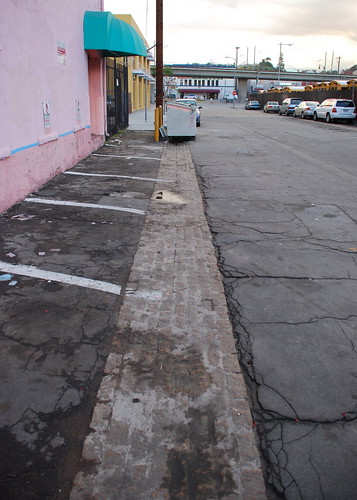
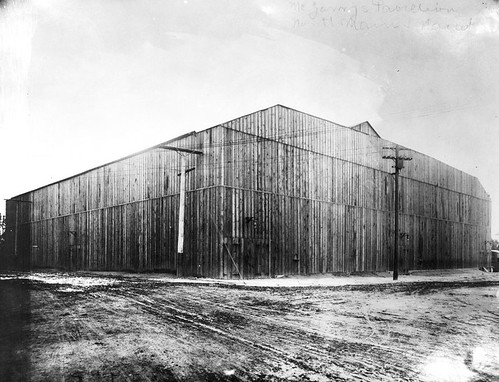
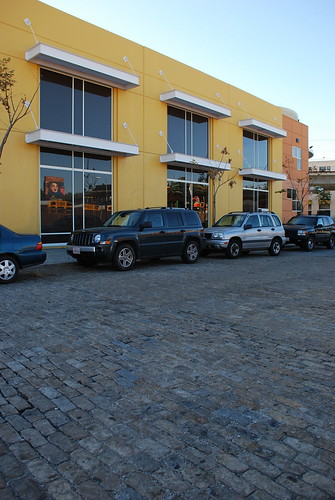
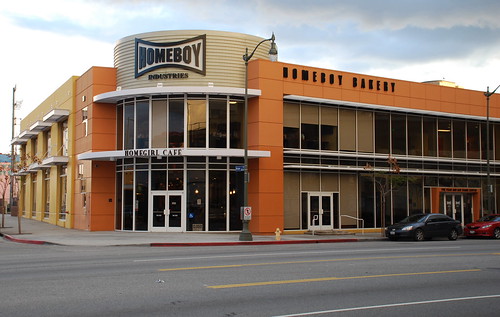
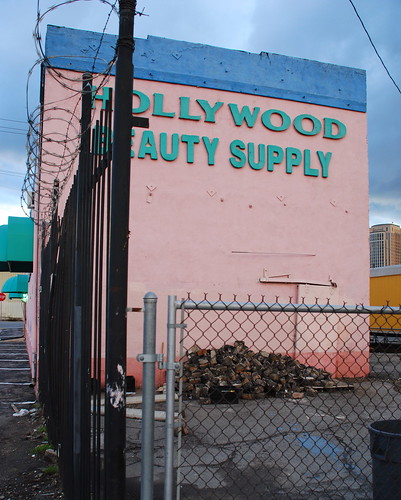
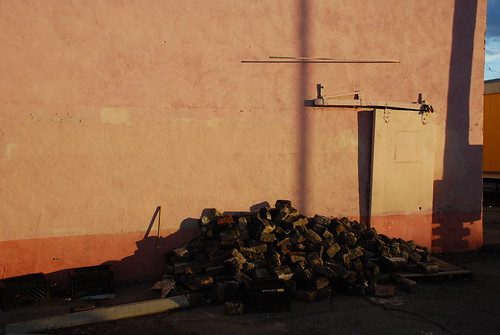


20 comments:
Interesting post! I have a couple of questions: Do we have any idea where these granite blocks were quarried? Were LA's cobblestone streets ripped up at one point and replaced with concrete or are there still cobblestones under the asphalt?
Thanks!
Hi, Steven. I have no idea where these were quarried, but at least two more sites - Werdin Place north of 3rd Street and a nearby alley - were discovered to have granite-block paving in 2004. But you'd think it's likely asphalt is covering up more, right?
This is one my favorite landmarks. It's probably the least-significant of all the landmarks, but here it is, part of Los Angeles' History, reminding us of what LA used to look like.
I wonder how or why the proposal to make this a monument in 1979 came about? Though I've seen lots of exposed brick paving around Los Angeles, could it be that this is the only granite paving to survive?
Though I haven't checked, there may still be some granite-block paving on Werdin Place (see comment above).
I'm wondering if the figure of 600,000 square feet for the warehouse in 1915 is a typo? Judging from the Sanborn map, the building's footprint looks to have been about 200x300 feet, or 60,000 square feet. To contain 600,000 square feet, the building would have had to be ten floors tall. That would have been one spectacular fire when it burned!
(This is whyaduck from Flickr, by the way.)
Ha! Whyaduck, you think too much. But, clearly, you've got to be right. I always think in terms of football fields, so when I saw 300 feet I thought, oh, one football field long (still pretty large). But, yeah, 600,000 square-feet, even over two floors, is kinda huge, still 300,000 square-feet per floor. So if it were 300 feet one direction, it'd have to be 2,000 (almost seven football fields) in the other. Probably not.
Homeboy looks to be doing well for itself. Great photo of a pile of Landmark "No. 211. Unbelievable.
I find it incredible that the pile is just lying there! Thats valuable stuff!
Does anyone know where 'The Rochester' or 'West Temple Apartments' once stood? According to some state records, it mentions Alameda & Bruno. Is it on the same site as the Union Warehouse?
Sharon23, check out HCM No. 11.
Thanks very much, it was RR property. This is an awesome site! This helps me locate the exact location.
Is Bruno Street still intact? I was down there a couple years back and there was nothing but a pile of granite blocks. Back in the 1980s, I took some shots of the pavement and there were railroad tracks.
Commercial Street near the LA River was paved with red brick. When they dug for the Red Line, all that went into giant trash gondolas. However, I was able to retieve a couple examples.
Cast into the clay was the legend "LA Paving Brick Co" and a couple arrowheads.
Thanks for the great web site.
Ray Long
Great blog! We're getting ready to do a historic preservation study of the pavers on College Street and your site turned up first in a search.
Thanks for the good work and keep it up.
John
I am looking for some information and I was wondering if one of you could help me. I use to live on the housing projects on Main St. aka Dog Town. Moved there in the early 70's. Back then, there was an old, white, two-story Victorian home just south of the projects. It was all by itself abandoned on a lot on the intersection of (but not certain) of Main St. and Bruno. Can someone tell me please what era this home was built and who it belonged too? They moved it or tore it down in the early 80's. email address is: teresa_valencia@sbcglobal.net
I love all the original paving in big cities as i think it adds character and history to the place however, with all the modernising going on in big citys, slowly but surely its all getting dug up and replaced with lifeless tarmac!...shame!
If anyone has ever been around the corner of Mateo and Palmetto st. there is a piece of concrete missing and a part of a red brick sidewalk uncovered.
Floyd, sorry late to the party as usual. Love your site and your photo-stream as well. As to McCarey's Pavilion it shows on the 1910 and 1914 Baist maps (plate 5) as being east of Main and Alhambra at the corner of Chavez and Queirolo streets. By the 1921 Baist it has disappeared. Best. MichaelRyerson
Hi Floyd, Thanks to your post, I recently visited Bruno Street. The paving bricks remain in service and look to have another couple of centuries in them. I wonder why they were quarrying granite bricks when fired bricks were, by 1900, in good supply locally. I wonder if they came to be in the neighborhood as a consequence of work being done in San Pedro and when they were no longer needed down there were simply commandeered for use here. How did you come upon the 1913 date for installation on Bruno St.? For what it's worth, although the stack of 'discarded' bricks has been moved and somewhat reduced, I was still able to acquire one for my small collection of Los Angeles artifacts. Thanks again.
Granite paving blocks pop-up all over Downtown Los Angeles with all the new construction and roadwork - particularly ion alleys. If I get the time, I'll take some photos of my favorite examples and post them.
The loose granite cobblestones that were stacked against that pink wall appear to have been used in making flowerbeds in the parking lot next door. When I went through some months ago, there was a small pile of loose ones and the indications of ongoing work.
Jasmin
Post a Comment